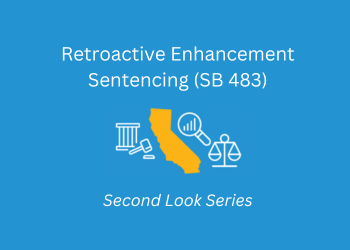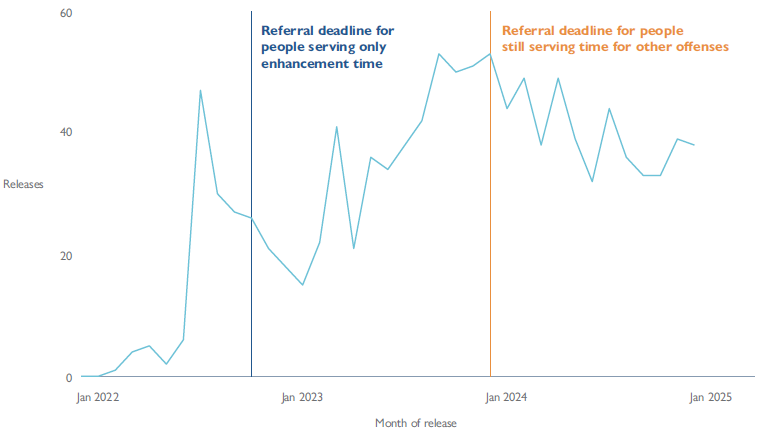- By:
- Category: Criminal justice

POLICY BRIEF: Retroactive Enhancement Resentencing under Senate Bill 483 (2022) ![]() This brief is part of the Second Look Research Series.
This brief is part of the Second Look Research Series.
Criminal justice system reforms — especially those revising sentencing laws — often have applied only to new cases. This means that individuals who were already sentenced under outdated laws will not benefit from the reforms. Prior to 2018, California law allowed a three-year sentence enhancement for anyone with a prior conviction for possession of a controlled substance who was later convicted of another drug offense. Senate Bill 180 (2018) repealed this enhancement except in cases involving minors. Similarly, Penal Code § 667.5(b) allowed a one-year enhancement for any prior prison or felony jail term. But, in 2020, Senate Bill 136 went into effect, restricting this enhancement to only be applied in cases where the individual had prior convictions for sexually violent offenses.
However, neither SB 180 nor SB 136 applied retroactively — meaning thousands of people remained incarcerated under enhancements no longer active in the state. To address this gap, Senate Bill 483 (effective 2022) authorized courts to resentence individuals serving time for enhancements repealed under SB 180 and SB 136. The goal of this bill, which was based on a recommendation from the Committee on Revision of the Penal Code, was to bring past sentences in line with current sentencing standards and reduce unnecessary incarceration.
This brief examines who was resentenced under SB 483, the offenses for which they were originally convicted, and the recidivism rates for people who have been released.
Second Look Research Series
The policy briefs focus on specific reforms:
Key Findings
1. More than 3,000 people have been resentenced under SB 483. Most of those resentenced (92%) had a one-year prior prison enhancement. As of December 2024, just over one-third had been released from prison.
Monthly releases of individuals resentenced under SB 483

Source: California Department of Corrections and Rehabilitation (2013-24).
2. People resentenced under SB 483 were largely Black or Hispanic and in their early 30s at the time of their offense. Black and Hispanic individuals made up 75% of those resentenced under SB 483, at 38% and 37%, respectively, with a median offense age of 31 across all racial and ethnic groups.
3. The median sentence reduction after resentencing under SB 483 was approximately two years.
4. People resentenced under SB 483 had typically spent a long time in prison. The median time in prison was slightly less than 13 years, and nearly two-thirds had served at least 10 years.
5. Early recidivism rates were slightly lower than the general release population. Among the 356 individuals with one year of post-release data, 18% were convicted of a new offense, compared to 21% of people released from prison in fiscal year 2018–19. Eight percent had a new felony conviction and 10% had a new misdemeanor.
Background: This research is made possible through a partnership between the California Policy Lab at the University of California and the Committee on Revision of the Penal Code, a state agency that studies and makes recommendations to improve California’s criminal legal system.
Suggested Citation: Skog, A., Lacoe, J. (2025). Retroactive Enhancement Resentencing under Senate Bill 483 (2022). California Policy Lab, University of California. https://capolicylab.org/retroactive-enhancement-resentencing-under-senate-bill-483/
